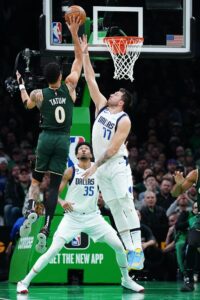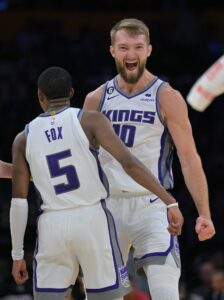Not every player drafted in a given year signs an NBA contract right away. Each year, at least a handful of draftees are “stashed” either in the G League or in various professional leagues around the world. The NBA team that drafted the player retains his exclusive NBA rights as he continues to develop his skills elsewhere.
Some of these players never end up making it to the NBA, whether by choice or because they don’t turn into an NBA-caliber contributor. Their draft rights eventually become more useful as placeholders in minor trades than for the possibility of the player coming stateside.
But many draft-and-stash players do eventually turn into useful contributors. Bogdan Bogdanovic, Davis Bertans, Cedi Osman, Dario Saric, Willy Hernangomez, Raul Neto, and Furkan Korkmaz are among the current NBA veterans who were stashed for at least one year after being drafted before signing an NBA contract.
Another member of that group? Nuggets star Nikola Jokic, the 41st pick in the 2014 draft, who remained in Serbia for a year before signing with Denver in 2015.
None of the players currently being stashed overseas are likely to turn into a Jokic-esque superstar at the NBA level, but there are certainly a few who look capable of cracking a rotation sooner or later.
Here are five of the most noteworthy draft-and-stash played worth keeping an eye on at the moment:
Vasilije Micic
- Current team: Anadolu Efes (EuroLeague)
- Drafted: 2014 (No. 52 overall)
- NBA rights held by: Oklahoma City Thunder
Long considered one of the best guards in Europe, Micic was the EuroLeague’s Most Valuable Player in 2021 and has been named the MVP of the league’s Final Four in each of the last two seasons.
It looked like there was a chance he’d make his way to the NBA for the 2022/23 season, but there were a number of hurdles to overcome. Micic was reportedly seeking a salary close to the full mid-level exception and wanted a real, defined role rather than just coming over to sit on the bench.
The biggest roadblock may have been the fact that his NBA rights are held by the Thunder — the Serbian would reportedly prefer to join a contender, and Oklahoma City remains very much in the rebuilding stage.
Despite some offseason trade rumors, the Thunder ultimately held onto Micic and he opted to re-sign with Anadolu Efes in Turkey. He’s once again thriving in EuroLeague play, ranking third in points per game (18.9) and second in assists per game (6.6) through nine appearances.
Micic will turn 29 in January, so if he wants to try to make his mark in the NBA, it probably has to happen soon.
Sasha Vezenkov
- Current team: Olympiacos (EuroLeague)
- Drafted: 2017 (No. 57 overall)
- NBA rights held by: Sacramento Kings
Vezenkov is coming off his best season in 2021/22, having led the Greek Basket League in scoring en route to an MVP award and a championship. He also earned a spot on the All-EuroLeague First Team.
The 27-year-old forward has looked even better so far in the ’22/23 season. Through 10 EuroLeague games, he’s second in scoring (20.1 PPG) and first in rebounding (8.7 RPG), leading Olympiacos to a 7-3 record.
After acquiring Vezenkov’s rights from Cleveland in a draft-day trade, the Kings reportedly planned to meet with him during the Las Vegas Summer League to discuss his future. However, that meeting didn’t end up taking place and Sacramento ultimately didn’t sign Vezenkov for the 2022/23 season.
It’s unclear whether it was the Kings or Vezenkov who backed off a potential deal, but based on how this season has played out so far, there’s reason to believe both sides could be more interested in teaming up next summer. Sacramento is off to a 10-7 start and has one of the NBA’s most exciting offenses, while Vezenkov is making a legitimate case for a EuroLeague MVP consideration.
Juhann Begarin
- Current team: Paris Basketball (EuroCup)
- Drafted: 2021 (No. 45 overall)
- NBA rights held by: Boston Celtics
Still only 20 years old, Begarin played a significant role for Paris Basketball last season during the team’s first year in France’s top league (LNB Pro A) and is doing so again in 2022/23. The French shooting guard is a long-distance threat who showed off his scoring ability in Las Vegas this July, averaging 18.2 PPG in five games for Boston’s Summer League team.
It makes sense that a team with title aspirations like the Celtics wasn’t necessarily eager to bring over a 20-year-old prospect right away, but it seems like it’ll be just a matter of time before he gets his shot.
Former NBA assistant Will Weaver, who is now Paris’ head coach, raved about Begarin last month, referring to him as an NBA-caliber player who “can make an impact in Boston.”
Filip Petrusev
- Current team: Crvena zvezda (EuroLeague)
- Drafted: 2021 (No. 50 overall)
- NBA rights held by: Philadelphia 76ers
Still just 22 years old, Petrusev already has an impressive international résumé. He was named Most Valuable Player of the Adriatic League (ABA) in 2021 as a member of Mega Basket, then won a EuroLeague title with Micic and Anadolu Efes in 2022.
The forward/center is currently playing for Crvena zvezda in his home country of Serbia and has been an effective role player in 10 EuroLeague appearances, averaging 7.0 PPG and 4.7 RPG on .543/.455/.625 shooting in 18.4 MPG. In five ABA games, his shooting percentages have been even better (.609/.800/.824).
Petrusev was reportedly interested in joining the Sixers this past summer, but there wasn’t room for him on a veteran-heavy roster. He has since expressed confidence in Philadelphia’s “plan” for him and said he believes competing in the EuroLeague will be a boon for his development.
Gabriele Procida
- Current team: Alba Berlin (EuroLeague)
- Drafted: 2022 (No. 36 overall)
- NBA rights held by: Detroit Pistons
Procida is one of eight prospects who are playing in international leagues this season after being selected in the 2022 draft. The Italian wing was the first of those eight players to come off the board in June and may be the most intriguing of the bunch at the moment.
Although he’s only 20 years old, Procida is playing a rotation role for Alba Berlin in EuroLeague competition, averaging 7.2 PPG with a .351 3PT% in 16.7 minutes per contest.
Procida’s contract with Alba Berlin is a three-year deal and details about possible NBA outs haven’t been reported, so it’s unclear if and when we might see him in the NBA. However, he told Orazio Cauchi of BasketNews that the Pistons are in frequent contact with him and visited him in Berlin, so it sounds like he’s in the club’s plans going forward.
 Still, Jokic ranks behind two players that remain atop Wright’s list for a second consecutive week. At No. 1, it’s Mavericks guard
Still, Jokic ranks behind two players that remain atop Wright’s list for a second consecutive week. At No. 1, it’s Mavericks guard  The Kings addressed their outside shooting in all sorts of different ways, drafting
The Kings addressed their outside shooting in all sorts of different ways, drafting